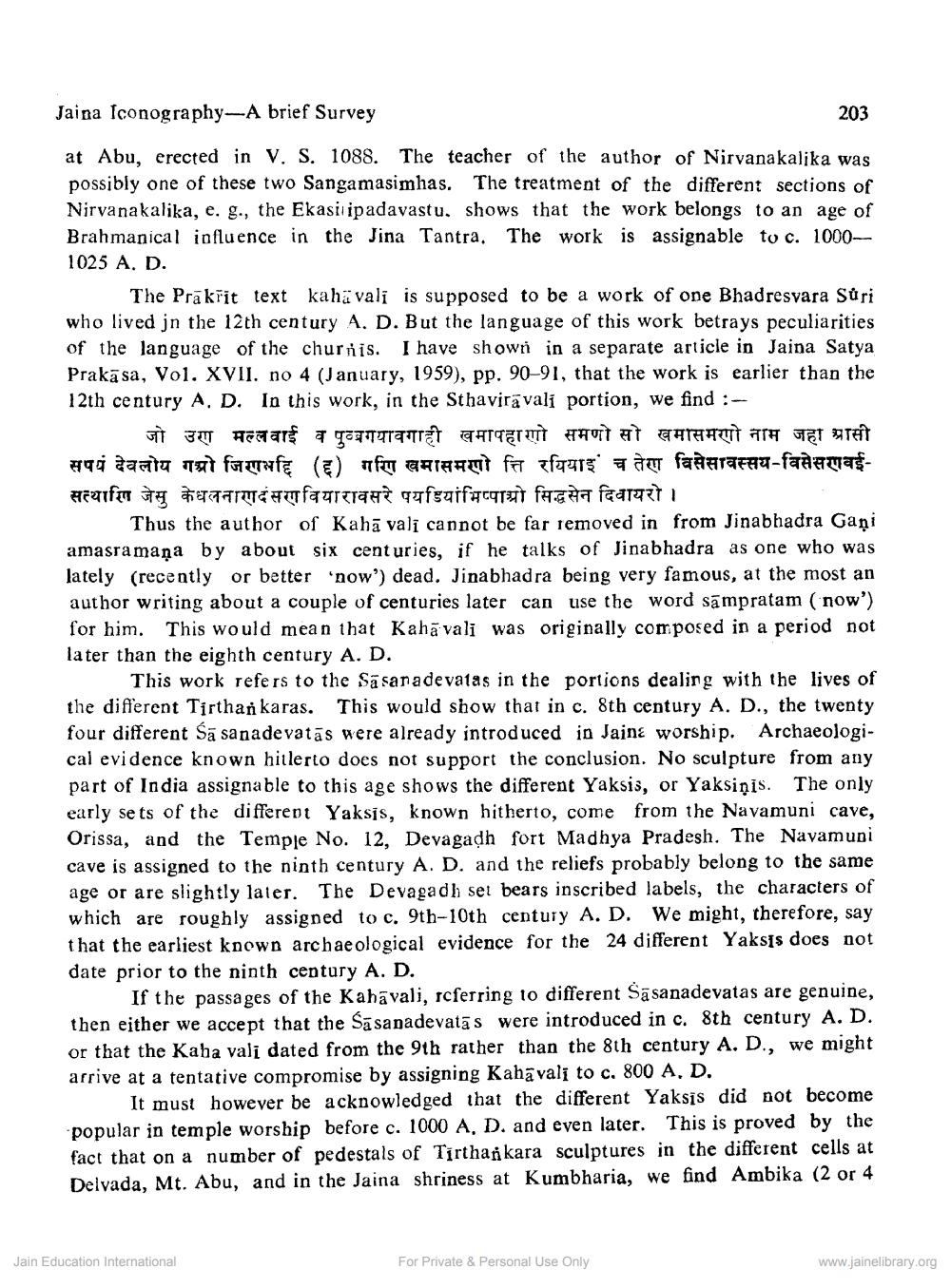________________
Jaina Iconography-A brief Survey
203
at Abu, erected in V. S. 1088. The teacher of the author of Nirvanakalika was possibly one of these two Sangamasimhas. The treatment of the different sections of Nirvanakalika, e. g., the Ekasiripadavastu. shows that the work belongs to an age of Brahmanical influence in the Jina Tantra. The work is assignable to c. 10001025 A. D.
The Prākřit text kahävali is supposed to be a work of one Bhadresvara Suri who lived in the 12th century A. D. But the language of this work betrays peculiarities of the language of the churnis. I have shown in a separate article in Jaina Satya Prakā sa, Vol. XVII. no 4 (January, 1959), pp. 90-91, that the work is earlier than the 12th century A. D. In this work, in the Sthavirávali portion, we find :
जो उरण मल्लवाई व पूधगयावगाही खमापहाणो समणो सो खमासमरणो नाम जहा पासी सपयं देवलोय गयो जिहि (ह) गणि खमासमणो त्ति रयियाई च तेण विसेसावस्सय-विसेसरगवईसत्यारिण जेसु केधलनाणदं सरण वियारावसरे पयडियांभिप्पासो सिद्धसेन दिवायरो।।
Thus the author of Kahā vali cannot be far removed in from Jinabhadra Gaņi amasramaņa by about six centuries, if he talks of Jinabhadra as one who was lately (recently or better 'now') dead. Jinabhadra being very famous, at the most an author writing about a couple of centuries later can use the word sampratam (now') for him. This would mean that Kahā vali was originally composed in a period not later than the eighth century A. D.
This work refers to the Sasaradevalas in the portions dealing with the lives of the different Tirthan karas. This would show that in c. 8th century A. D., the twenty four different Śā sanade vatās were already introduced in Jaina worship. Archaeological evidence known hitlerto does not support the conclusion. No sculpture from any part of India assignable to this age shows the different Yaksis, or Yaksinis. The only early sets of the different Yaksis, known hitherto, come from the Navamuni cave, Orissa, and the Temple No. 12, Devagadh fort Madhya Pradesh. The Navamudi cave is assigned to the ninth century A. D. and the reliefs probably belong to the same age or are slightly later. The Devagadh set bears inscribed labels, the characters of which are roughly assigned to c. 9th-10th century A. D. We might, therefore, say that the earliest known archaeological evidence for the 24 different Yaksis does not date prior to the ninth century A. D.
If the passages of the Kahāvali, referring to different Sāsanadevatas are genuine, then either we accept that the Sāsanadevatās were introduced in c. 8th century A. D. or that the Kaha vali dated from the 9th rather than the 8th century A. D., we might arrive at a tentative compromise by assigning Kahāvali to c. 800 A, D.
It must however be acknowledged that the different Yaksis did not become popular in temple worship before c. 1000 A, D. and even later. This is proved by the fact that on a number of pedestals of Tirthar kara sculptures in the different cells at Delvada, Mt. Abu, and in the Jaina shriness at Kumbharia, we find Ambika (2 or 4
Jain Education International
For Private & Personal Use Only
www.jainelibrary.org




